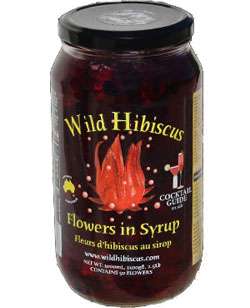Wild Hibiscus Flower

The Wild Hibiscus Flowers in Syrup was "discovered" by happy accident at a lively Australian dinner party in 1998, when Lee Etherington and a group of (tipsy) friends playfully dunked a crimson wildflower into a champagne flute.
The flower slid gracefully to the bottom of the glass, and the friends watched, agog, as champagne bubbles streamed across it, and the petals slowly unfurled. Lee, a 21-year-old tour guide who owned a small food business and had only ever used the edible Hibiscus as a dessert garnish, took a sip of his exotic creation.
It was a Eureka moment.
Nine years after that fateful dinner party, the Wild Hibiscus Flower creation is a hot topic of conversation - and an icebreaker - at dinner parties around the world.
It is found in upscale bars and restaurants and prestigious retail stores in 16 countries worldwide, from the posh Dorchester Hotel in London to gourmet grocer Citarella in New York.
Following the dinner party epiphany, Lee began developing the Hibiscus product, and subjected it to the most reliable market research he knew - the tourists from Europe, the United States, Asia and elsewhere, who he led on daily treks through the scenic Blue Mountains, northwest of Sydney.
The Wild Hibiscus Flower was a standout hit with clients, so Lee spent the next few years developing the product. In 2005, as the volume of exports exceeded domestic sales, Kurrajong Australian Native Foods became the Wild Hibiscus Flower Company.
As the product has grown in popularity, The Wild Hibiscus Flower Company has remained a family-owned and operated business. They believe that to earn "gourmet" status, a product must be made with individual care and attention to the highest standards. As the Wild Hibiscus Flowers in Syrup blossomed, a conscious decision was made not to mechanize or outsource the production - a growing trend in the high-end food market - but to continue creating the product by hand, the best way they know how.
Lee researched how to grow the Wild Hibiscus, who could grow it, where to grow it, how to harvest it, how to manage it after harvest so the hibiscus remained in peak condition, and, most importantly, how to consistently process the fresh flowers into the Wild Hibiscus Flowers in Syrup. To that end, Lee devised a natural preservative - a mix of spring water and Australian cane sugar - that keeps the flowers fresh for up to 24 months.
The staff is trained to treat each Hibiscus flower with care. The flower they're holding is destined for a discerning consumer who appreciates and expects a premium product, whether it's a bride on her wedding day, a celebrity, a mother celebrating a special occasion or a group of women enjoying a big night out.
Under the company's supervision, contracted growers in tropical northern Australia produce and hand pick the crops of flowers, 25 percent of which are certified organic. The fresh flowers are individually picked, deseeded, cleaned and packed into jars entirely by hand at the factory in the tiny village of Kurrajong, in the foothills of the Blue Mountains. Hibiscus flowers grow in several different shapes, so they are placed in predetermined positions in the jar according to shape, to ensure that none are squashed.
With such a labor-intensive process, it's difficult to produce vast volumes of our product at speed, but the output of their careful but efficient production process meets the export demands of iinternational markest.
Browse all 14 Wild Hibiscus Flower Drink Recipes